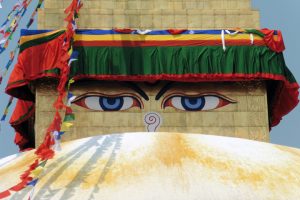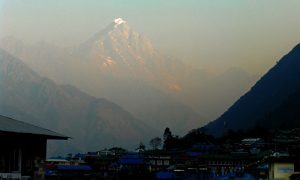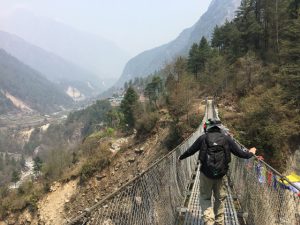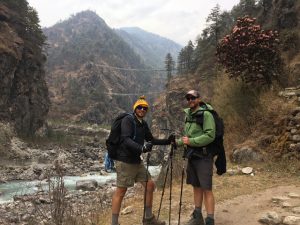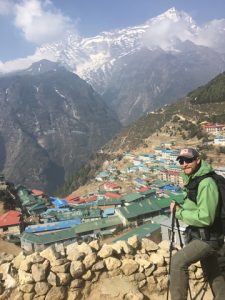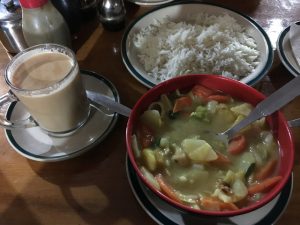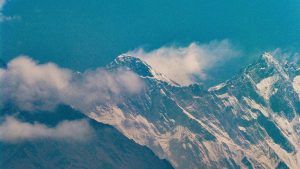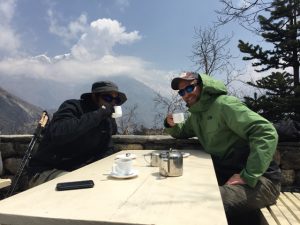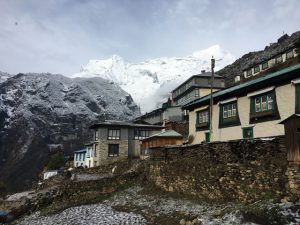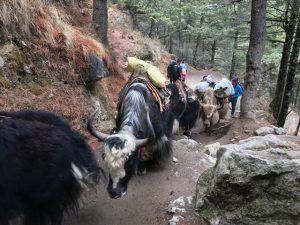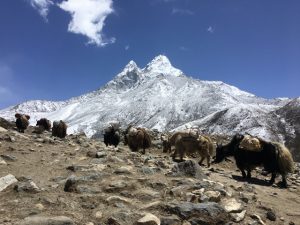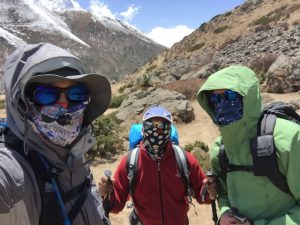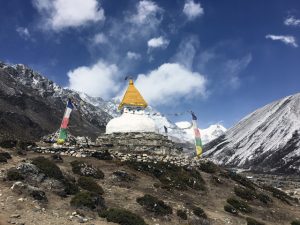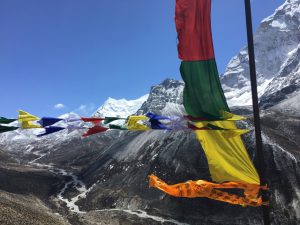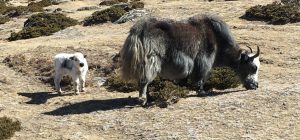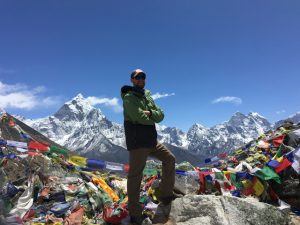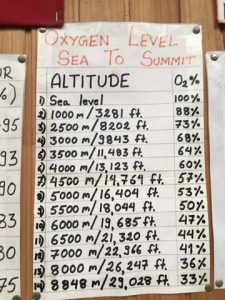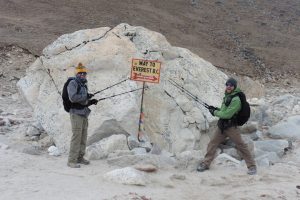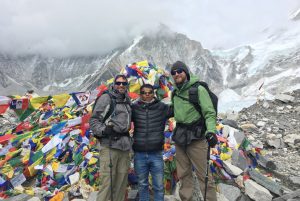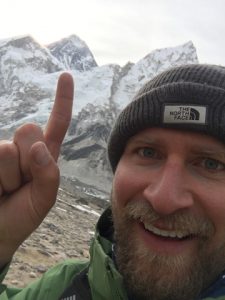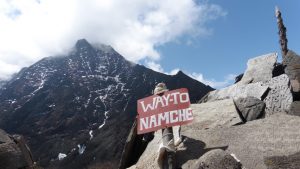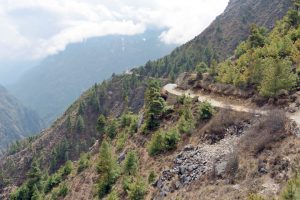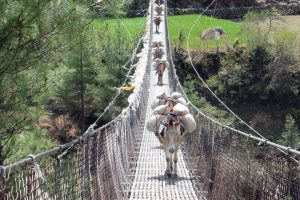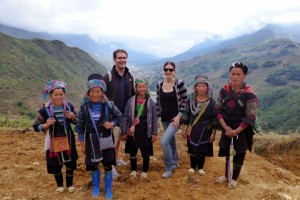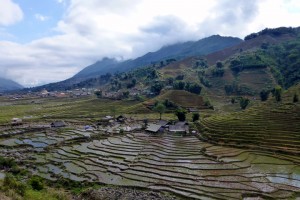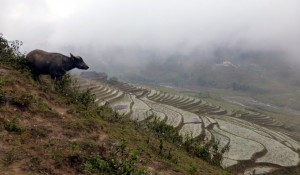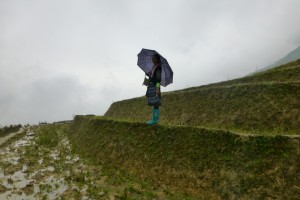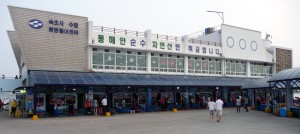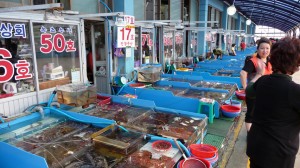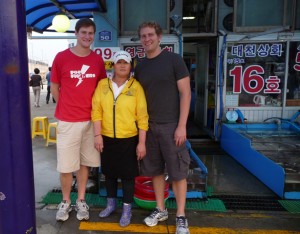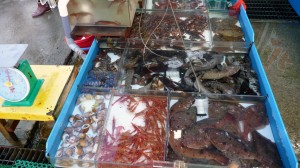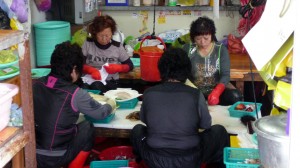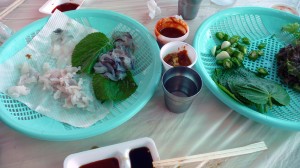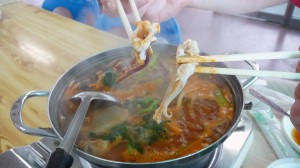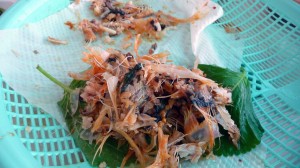Truly an adventure. 8 days up. 3 days down. Kathmandu > Lukla > Phakding > Namche Bazar > Deboche > Dingboche > Loboche > Gorak Shep > EBC > Kala Patthar > Pangboche > Namche Bazar > Lukla > Kathmandu!
Things to remember for next time:
- Take the Diamox/Acetazolamide (altitude sickness medication) starting at Namche Bazar
- Bring plenty of toilet paper ($5/roll at the top)
- Bring hot sauce for food (menu is the same at every place)
Kathmandu
If you’ve been to a dusty, noisy, congested Southeast Asian city, you’ve been to Kathmandu. There are heaps of prayer flags, sacred Hindu sights, and the great Buddha eyes, those eyes…
Buddha Eyes
The best reason to go to Kathmandu is to get to the trekking region! Shall we?
Day 1 – Kathmandu to Lukla to Phakding
Flying from Kathmandu to Lukla is a trip in itself. It was… a little scary. The runway is sloped uphill to slow the planes while landing, and it helps them speed up on takeoff.
When I got out of the plane, I immediately noticed the sky-scraping mountains.
View from Lukla
From Lukla (9,383′) we hiked to Phakding (8,562′). I’ll track the elevation because it will quickly become more impressive! The hike to Phakding was along a river, in a valley, across suspension bridges, and adorned with prayer flags.
Trekking to Phakding
I immediately noticed the incredible height of the mountains above me. In my past hiking experiences in Colorado, the peaks were never that much taller than you. You start maybe at 8,000′ or 10,000′ and hike to 13,000′ or 14,000′. In the Everest region, peaks you can see are miles above your head. At my highest point, 18.037′, I could see the top of Everest, but it was still 11,000′ above my head!
Day 2 – Phakding to Namche Bazar
The first day I thought, this isn’t that hard. Well, we actually LOST elevation the first day. Day 2 was the first “real” hiking day. Phakding, 8,562′, to Namche Bazar, 11,286′. It was a little more difficult, but again, nothing crazy.
Trekking to Namche Bazar
The last part of the hike was over the top suspension bridge in the background of the above picture. The hike brought us to the last big city int he Everest region, Namche Bazar, ATM included!
Above Namche Bazar
We were eating some tasty food, below is a bowl of sherpa stew with milk tea and rice. The other staple was Dal Bhat, kind of a vegetable curry. We aggressively ate them in the beginning, but 7 days later… it because very, very, very repetitive (hence the hot sauce recommendation).
Sherpa Stew
Day 3 – Acclimatization Day in Namche Bazar
First views of Everest!
On the acclimatization day, we hiked from Namche Bazar to the Everest View Hotel for our first view of Everest and a cup of coffee.
After our cup of coffee we hiked back down to Namche Bazar, relaxed, explored the curio shops, and prepared for the next day.
Day 4 – Namche Bazar to Deboche
Snow awaited us when we woke up! Then off to Deboche (12,168′).
Namche Bazar
There were many Yak-if (Yak traffic) jams on the trails. You just had to wait it out! And also stand up the mountain from the the yaks because you wouldn’t want them pushing you off the trail, tumbling down the mountain, as they passed.
Yaks
Day 5 – Deboche to Dingboche
A beautiful hiking day! Also the highest elevation I’d been in my life and the first day of altitude sickness… We hiked from Deboche (12,168′) to Dingboche (14,469′).
A view of Ama Dablam
Keeping out the dust
Arrival at Dingboche
The tallest peak in the continental United States is Mt. Whitney, 14,505′. I’ve hiked above 13,000′ with no problems. But hiking at altitude and sleeping at altitude depletes your body and by hiking to 14,469′, I began to encounter headaches, mild dizziness, and shortness of breath at night. Not fun! Despite these issues, we chose only to take the altitude medication “in case we really needed it.”
Day 6 – Acclimatization Day at Dingboche
In the morning, we did a short hike about a 1,000′ higher than where we stayed. The views were spectacular as usual.
Day Hike View from Dingboche
When we got back from the hike, we were generally feeling terrible with headaches and sleepiness. But it seemed like everyone around us was having the time of their lives! It didn’t make sense, was everyone else in better shape than us? Trained harder? Something else? We asked around, “are you on Diamox?” The overwhelming answer was, YES! We figured that was why everyone else looked happier than us, so we popped the pills.
Day 7 – Dingboche to Loboche
The next few days kept breaking my personal record for highest altitude ascended. We were off to Loboche (16,104′)!
Baby Yak!
Just another great view
Altitude…
The above picture is one of my favorite. It was at our “hotel” in Loboche. According to the chart, we were around 55% oxygen compared to sea level. I can’t say we were feeling great, but the effects of altitude seemed to be stuck at just mild headaches. Was the Diamox helping? I assume so. We did see someone collapse on the side of the trail and there was an almost endless flow of helicopter traffic from the mountain trails back to Lukla, so at least we weren’t that bad!
Day 8 – Loboche to Gorak Shep to EBC!
The morning was spent hiking to Gorak Shep (16,859′), we had lunch (more Dal Bat – real tired of it at this point), and then to EBC (17,846′)!
We kept wondering, where is Everest? Where is Everest? Well, you actually can’t see Everest that much on this trek, we did catch a glimpse on the way to EBC, but it was generally cloudy that day and didn’t get a good view.
EBC “summit” with our guide!
EBC
Day 9 – EBC to Kala Patthar to Pangboche
The hardest day by far. We woke up at 5a.m. to hike to the highest point of our trip, Kala Patthar (18.037′), and the best views of Everest!
Everest is the black triangular peak to the left of the highest peak in the picture
Everest is directly above my finger
Once we reached Kala Patthar, we hiked back to Gorak Shep for breakfast, and then hiked a looooooooong 10 miles down to Pangboche (13,074′). Exhausting!
Day 10 – Pangboche to Namche Bazar
At this point, we were just on the dusty road home, hoping that the water for the shower was hot in Namche Bazar (it had been a while).
Trekking back to Namche Bazar
Day 11 – Namche Bazar to Lukla
What took us 8 days to get up, only took us 3 days to get down. Our pace was fast, only hindered by the occasional donkey in the way.
Day 12 – Lukla to Kathmandu
Everyone we met, our guide, our porter, the other trekkers were incredibly nice, everyone was there for the same reason – to enjoy this beautiful earth! EBC trek was not a vacation, it was an incredible adventure!
Flight back to Kathmandu

